1. The Blue Light Project is published in paperback at the same time as being selected as a contestant for a reality-television-styled vote-based Bookie Award.
2. The Red Gate artists’ collective has found a potential new home, but needs City of Vancouver approval to move in as the City owns the property.
The connection is forged by my knowledge that The Blue Light Project might never have been written were it not for the Red Gate.
This is the piece of art that started my whole creative process. 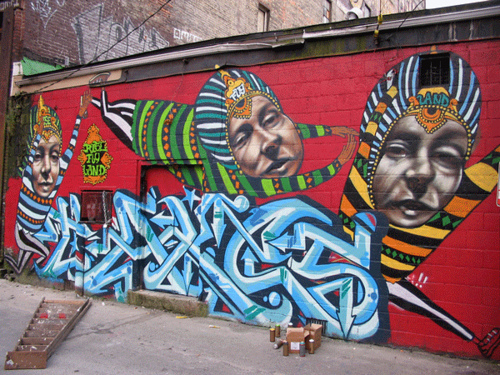
It’s called Rise Fly Land and the day I first saw it, I stood in that alley for a good twenty minutes staring at it. At that point in my exposure to graff and street art, I didn’t know enough to recognize that signature at the bottom, which is that of the legendary Canadian graff writer (and almost equally legendary train-rider) Take5. All I knew was that there was something mysterious and entire in the image. Rise. Fly. Land. There is a echo of eternity in the phrase. A bass note of wisdom, of peace.
I had only very recently seen Les Blank’s oddly captivating filmWerner Herzog Eats his shoe in which Herzog makes the following slightly enigmatic statement: “We need adequate images. If mankind doesn’t develop adequate images, we’re going to die out like the dinosaurs.”
Somehow standing in that alley off Hastings Street, I felt like I was confronted with an authentic attempt at an adequate image. It was a moment both warming and chilling, if that makes any sense.
Of course, like I said, I had no idea who had made the piece. Until I talked to Jim Carrico at the Red Gate, that is. And he introduced me to Take5 who then told me that he and the artist OTHER had made Rise Fly Land. Take5 also gave me my first glimpse into the world of the street artist in a long and fascinating conversation in the original Red Gate location. From there, literally branching out from the Red Gate and into this hidden community of artists, my interest in the area and my ideas for the book began to surge and take shape.
The Red Gate always was a chaotic place, with no particular central plan or manifesto. But it was from that environment that came the sparks of original idea.
When the Red Gate was threatened with shut-down last year, I lamented the prospect in a Vancouver Review essay called Chaos and Planning. In that piece I argued that the Red Gate was the source of creative chaos that all cities need. Kill these sorts of institutions – out of some hyper-vigilant sense that everything has to be planned centrally in coordination with official messages – and you kill the organic creativity on which all cities depend.
My article didn’t help. The Red Gate lost it’s fight and were evicted. It was a real loss to the city.
Now we come to another turn in the story. The Red Gate has a chance to reopen. The building they want to use is empty. They’re willing to pay rent. And the whole situation is in the hands of the City of Vancouver, as they own the building.
Is it possible that our civic leaders will miss for a second time the contribution that the Red Gates of this world make to the cities where they’re found?
On the cover of the paperback Blue Light are three eyes, by the artist Rich S. For awhile prior to the Olympics in Vancouver, these could be found widely through the downtown east side. I loved those eyes. What a lot they managed to say in one image about the hovering reality, good and ill, of our governments and leaders.
What will our leaders in Vancouver do now?
]]>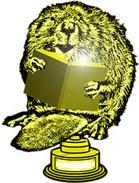
The Golden Beaver
The Blue Light Project has been nominated for a CBC Bookie Award. Thanks to the CBC producers who included me on a list with Patrick deWitt, Esi Edugyen, Brian Francis and Elizabeth Hay. Those are amazing writers! I’m truly honored.
That said, it’s fascinating that this particular novel would be nominated for this particular prize.
The Blue Light Project is the story of a lone street artist, Rabbit, who pulls off a city-scale installation so beautiful that it stops chaos in its tracks. The chaos in question is a hostage crisis. A man storms a TV studio where they’re taping a cynical reality show called Kiddiefame. The man has a bomb. He seals the studio with a bunch of kids inside. The surrounding city descends into bedlam as confusion mounts. The power of Rabbit’s installation is that it umbrellas the city in a moment of intense splendor. But the work also mesmerizes people by magnificently opting out of the intense rivalries that animate shows like Kiddiefame and the broader culture the show reflects.
Rabbit’s art rises above. And dazzled by the vision of it, people are moved and changed.
Obviously, Kiddiefame wasn’t an arbitrary choice. It represent entertainment in our era. What television show isn’t “reality” now? Check out food TV. Five years ago Mario Batalli was sharing recipes. Now he’s battling to the death in Kitchen Stadium. But the whole television product has shifted that way, as television critic John Doyle recently lamented. Everything on the tube now seems to be about people getting chopped and eliminated and dragon-denned into submission.
Literature used to stand aloof from all this mano-a-mano action. At the Giller Prize ceremony with Stanley Park, I recall feeling real sympathy for my fellow nominees. We were all in the same boat, tossed together on the seas of fate. Competition between us was purely abstract since there was nothing we could individually do about anything.
Online voting competitions change that dynamic completely. You can choose not to self-promote (more on that in a minute). But candidates can absolutely influence results. If a vote is your objective, the Tweetiest and most Facebookie candidate can indeed win. Klout = clout.
The Bookies are precisely tuned to the cultural moment, in other words. And their impact will compliment other developments which now extend the writer’s job far past merely writing the book. Post-publication is now the busiest season, where the author needs to be out there working the networks, pumping hands and kissing babies, on the stump, looking for love.
In all of that activity, however, it’s worth pausing to reflect that literature in a contest for votes is just the stock market with French flaps. Art might save us, as it promises in the conflicted world of my novel. But there aren’t very many people left in our real and conflicted world who think the stock market can save us now.
None of which should be taken to mean that I feel above it all. I set up a Facebook page for Blue Light. I’ve been nominated for Canada Reads, previously. I Tweet (@Timothy_Taylor_). I’m part of the phenomenon.
Do I sit this one out, then? Well, I won’t email the universe. I won’t Facebook or Tweet anything other than this post. Not because I don’t want to win. Of course I want to win (although I’m pretty sure Patrick will nick the prize for his wonderful book). But it’s academic, because you can’t very well ask people to make you the most popular for a book that ruthlessly criticizes that very social impulse.
I could vote for myself, of course. I have already. I discovered that by opening and closing Firefox I can vote for myself endlessly. I could probably squeeze in several thousand votes for myself before the month end. I could RoboCall my way to a win!
And I was tempted, I confess. After all, I’ve been nominated for book prizes and never won. A favorite magazine editor once said to me: dude, you better win one of these soon or you’re going to go down as the Susan Lucci of Canadian letters.
But I won’t. I promise. I will vote only as many times as there are days remaining in the contest, as per the rules. I’ll enjoy the irony and go on to what I now think of as the blissful part of the publishing cycle. I’ll just get busy on this next book.
It’s going to be a winner.
]]>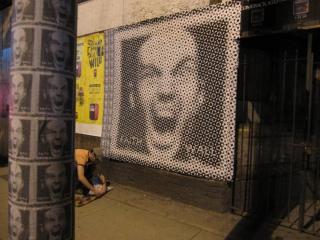
Faith Wall Camden Town?
Holy stickers Batman. These things have hit Toronto, New York, Halifax… everywhere.
Now they’ve reportedly crossed the pond. They’re going up in the UK now.
Move over Banksy. Or whatever. I have no idea what this means.
]]> The Blue Light Project weirdly presages this extraordinary news story: WikiLeaks founder Julian Assange has told smartphone and email users “You’re all screwed”, as he unveiled his latest publications.
The Blue Light Project weirdly presages this extraordinary news story: WikiLeaks founder Julian Assange has told smartphone and email users “You’re all screwed”, as he unveiled his latest publications.
The 287 documents Wikileaks has released point to 150 agencies around the world that are making use of *existing technology* to monitor people’s phones and computers. Software and hardware to perform this “mass surveillance” is being sold by intelligence contractors around the world and allows for data collection targeted at “entire populations”.
That news is strange and scary enough. But in The Blue Light Project, the main character Rabbit has a very particular backstory. He used to work for a secretive company developing phone software. Here’s the relevant excerpt. Bear in mind that what’s being descibed in this passage was SciFi in my mind as I wrote it. But as I was writing about the very near future, it should perhaps be no surprise that the SciFi future was (at least according to Assange) happening already, only in the folds of secrecy that surround our present moment.
Excerpt from The Blue Light Project:
“Nobody was dying as a result of my work, I realize that,” Rabbit told Eve. “There were jobs at Raytheon and Intel where I could have worked on control systems for cluster bombs and joint stand-off weapons. I was working on a phone. I was helping design the newest, latest, hottest version of a device most people use to order pizza, text their friends.”
<?xml:namespace prefix = o />
But what a phone. What an idea. From a technical standpoint, it had been fun to work on. Naturally it was also an internet device and a video camera and a GPS and a music player. And yes, the prototype was also designed with an integrated biometric fingerprint and retina scanner, so the device was useless if it was stolen, and it could also log user medical information like blood pressure, blood type, pulse rates, et cetera. But the fact that it could do all those things was secondary to the phone’s chief innovation, which was a function that would ultimately be invisible to its users.
“And what was that?”
“It listened to you,” Rabbit said.
Eve thought about that one for a second or two. “Don’t all phones listen to you?”
“Not actively,” Rabbit said. “They just transmit. And even so, they generally don’t transmit unless you’re on a call.”
Eve was trying to work this through. “The phone was designed to eavesdrop?”
User intelligence, they called it. Or sometimes: behavioral fingerprinting. The phone was designed to sample the life of its user: ambient noises, television shows on in the background, music choices. The system then synched that data up with all the other information collected—downloads, GPS logs, voice traffic, medical data—and built a user profile that allowed the device to assemble phone books or web links, push ads and suggestions at you through the browser, even dial 911 and transmit medical data in the case of certain medical emergencies.
“Which was maybe a little more phone than some people would want,” Rabbit said. But what was a lot stranger, what really got into Rabbit’s head and wouldn’t come out, was the client-side request late in the project timetable for silent dial-out functions.
“Silent what?” Eve asked.
Dial-out. These capabilities enabled the phone to upload user profile data to pre-set third-party locations.
“As in, without people knowing,” Eve said.
Rabbit shrugged. Conceivably without them knowing, yes. The phone could have been designed to do that. He, personally, never got that far with it.
“Because you realized all this would be completely illegal?” Eve asked.
“It wasn’t illegal to test it,” Rabbit told her. “We were designing a prototype. A feasibility study.”
MADDAM, the client called it. Massively Distributable Data Acquisitions Module. Rabbit didn’t remember thinking once about what the device might represent if half the country or half the world owned one until that late client request that upload features be developed. And if there was any chance Rabbit was going to get his head around that part, there was much less of a chance the following morning when a whole raft of new nondisclosure agreements were shipped over by the client’s lawyer to be signed immediately and returned. Rabbit signed. But why the paranoia? What exactly had they been working on?
“Maybe we really were just tossing around ideas for a super-smart phone,” Rabbit said. “But that morning I realized I just didn’t know. Maybe I was developing the most sophisticated low-maintenance wiretap the world had ever seen. Selling people stuff and surveillance have a big overlap, if you’re seeing my point here.”
“I am. And I’m scared to ask the next part,” Eve said.
Rabbit nodded. He knew where this all led if you thought about it.
“Who was the client?” Eve asked.
“Short answer?” Rabbit said. “Nobody I worked with had any idea. We used a code name in house. Blue 52.”
“Blue 52,” Eve said. “And who did you think that might be?”
*****
Please consider buying the book.
]]>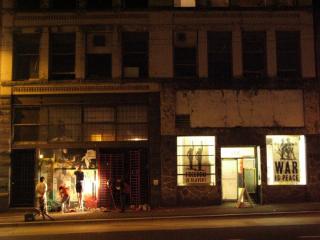 I’m mid-way through a piece for Vancouver Review on the topic of public art. As a result, I wouldn’t normally write and post anything on the topic because it might end up stealing from work to-be-published. But, with apologies to my kind and forbearing editors at VR, I’m going to make an exception here because we have an unusual and troubling art situation going down here in Vancouver: the City has threatened to shut down the Red Gate.
I’m mid-way through a piece for Vancouver Review on the topic of public art. As a result, I wouldn’t normally write and post anything on the topic because it might end up stealing from work to-be-published. But, with apologies to my kind and forbearing editors at VR, I’m going to make an exception here because we have an unusual and troubling art situation going down here in Vancouver: the City has threatened to shut down the Red Gate.
If you’re not familiar with it, the Red Gate is a non-profit space at 152 West Hastings Street opposite the Woodwards redevelopment. Run by Jim Carrico, it’s a kind of pure creative space (he calls it a Cultural Wildlife Refuge) where musicians and artists (street artists and others) hang out, create, and showcase their work. About three weeks ago the City gave Carrico 30 days to vacate. After a flood of protest, the City granted a 60 day extension. But the axe still hangs meaning the time has arrived for people to make themselves heard on the topic of why this closure should not happen and why Vancouverites should really care about the preservation of the Red Gate and institutions like it.
What’s driving this situation is development in the Downtown Eastside (DTES). As most Vancouverites know, the 100 block of West Hastings Street has already transformed with the completion of the new Woodward’s complex. And speaking as a 15 year tenant of the Dominion Building, at the corner of Hastings and Cambie half a block from the Red Gate, I feel qualified advancing the opinion that the Woodward’s development was sorely needed. 100 block West Hastings was never the worst block in the DTES, but when I moved my office into the area it was getting steadily worse. I saw crack use and drug sales almost every day, all the way up Hastings and into Victory Square. I remember bringing my kid to the office one weekend and having to jump in and stop him from picking up a hypodermic needle lying next to the cenotaph.
Having said that improvement was needed, it’s important to note that DTES “gentrification” was never the plan. I wrote an articlelast year about Army&Navy owner Jacqui Cohen and interviewed numerous prominent people about development of the DTES. Every one of them – including Larry Beezley, Jim Green, Bob Rennie and Cohen herself – stressed that “gentrification” was not the right approach. For the downtown, these powerful people seemed to agree, the “mixed use” model was better.
Why did they express this view? Because while “mixed use” plans try to preserve what’s best about a neighborhood through diversity, “gentrification” is what happens when you do development wrong. It means allowing lower income groups and artists to be displaced and, in the process, chasing out the established culture of a given area.
And make no mistake: there has been a distinct DTES culture. It’s about affordability, certainly. But it’s also about the sheer presence in numbers of artists, gallerists, filmmakers, writers, publishers, theater troupes, as well as a whole range of independent business people in technology, architecture, the law. What I’m describing is the kind of neighborhood on which every city vitally depends, those urban zones and spaces where small-scale creativity is expected, celebrated, and where it can thrive.
The Red Gate has been a critical part of that scene in the DTES and should be part of the neighborhood’s continued “mixed use”. I can give a personal example. I wrote a book recently, a novel called The Blue Light Project. Why? In large part due to the inspiration I found myself drawing from the DTES flourishing ecology of street art. I wasn’t a street artist. I was a total outsider. But I started my investigation at the Red Gate, where Jim Carrico arranged for me to meet the legendary Vancouver graff writer and street art historian Take5. Take was my window in, and through various introductions that followed, my own creative process was informed and stimulated. When I follow the causal chain, in other words, it goes back from my finished book through all of the people I met, through Take5 and the Red Gate, to the DTES itself.
And it seems to me that’s exactly how creativity is supposed to work in these most crucial urban zones. People are supposed to be positively infected by what’s going on around them, to be forced into an intellectual and aesthetic jostling together. Because it’s in those cultural mosh pits – at times anarchic, sure, but generating hugely productive creative energies – that new ideas are born.
New ideas. We want those. So we don’t want to stomp all over the places where they are cultivated. And that’s why people who care about this city, like those named above, may support mixed use development of the DTES, but not “gentrification” where you drive everybody out who isn’t a upmarket condo owner. That’s why, I’d reason, Gregor Robertson has reportedly said that he wants the Red Gate to stay open. Because people who care about the city recognize that gentrification is not just unfair, it kills a particular kind of urban creativity. And to do that would kill something essential to the entire city.
Let’s not let that happen. I encourage anyone who reads this post and agrees to write a letter of support to [email protected]. It’s not going to be easy. First thing Jim needs is an agreement from the building’s owner regarding long term occupancy, without which the building won’t qualify for the City’s Cultural Infrastructure Grant. But if enough noise is made, perhaps the pressure can be constructively applied in this case.
Timothy Taylor
]]>
Werner Herzog
“We need adequate images, or we’ll go the way of the dinosaurs.”
Herzog has said this numerous times. I think it’s one of the most critical ideas of our time. It was true in the 70’s when he first said it. It’s more true today. In The Blue Light Project, I built my street artist character Rabbit around the inspiration of this idea. Herzog said what he said. I imagined someone taking him very seriously and responding with artistic action. With images. With an attempt at adequacy.
Here’s a review from Toro Magazine, by William Morrasuti, that senses the critical placement of that Herzogian idea in the novel.
***
The Blue Light Project, a timely, even prescient new novel by Timothy Taylor, opens with a warning: if human beings don’t develop adequate images, they’ll die out like dinosaurs. This notion, which the reader first encounters in an opening quote from Werner Herzog, turns into a leitmotif – and it culminates when one of the central characters, a street artist named Rabbit, stumbles into a movie theatre and hears these same words just as he’s undergoing a personal crisis.
“I’ll never forget the words,” Rabbit told Eve. “Herzog said: if you switch on television it’s just ridiculous and it’s destructive. It kills us. And talk shows will kill us. They kill our language. So we have to declare holy war against what we see every single day on television.”
Rabbit’s holy war is, ultimately, The Blue Light Project itself – a large scale art installation that blossoms phoenix-like out of the carnage (psychological and otherwise) of a grim, embattled city.
Each of the main characters is adrift. Thomas Pegg, a disgraced journalist, has lost everything to a plagiarism scandal. Eve Latour, a gold medal-winning Canadian Olympian, is haunted by a sense that her missing brother is still alive.
As the protagonists navigate personal crises, a larger calamity grips the city: a gunman carrying a bomb walks onto a reality TV show, kills several people and takes a group of children hostage. We later learn that the kidnapper, a former government interrogator, refers to himself as Mov – a nod to Movsar Barayev, the Chechen leader of the Moscow Theatre Crisis, a tragedy that took place ten years earlier.
The Blue Light Project is, on one hand, a serious novel that tackles big ideas. For instance, it’s no coincidence that the act of terrorism occurs at “Meme” Media – and, in conversation, Taylor acknowledged an intellectual debt to Rene Girard, the French academic, literary critic and philosopher who wrote about the role of mimetic desire and sacrifice in human evolution.
“As I was thinking about the function of sacrifice in our culture,” Taylor said. “I became increasingly certain that’s what is significant about reality TV. We allow people to step out of everyday life, elevate themselves significantly towards fame, and then let them go. And we tear them down. Someone has got to fail. And so if this is in fact lurking in the soul of human culture, then celebrity would be this superficial, half-real, safe version of it.”
Part of the charm of the novel is that, in concert with such serious considerations, the narrative hums along with an appealingly cinematic aesthetic. In fact, reading this book is like being immersed in a tense thriller yet with all the linguistic pleasures of a well-crafted novel. A case in point: the briefcase bomb that Mov carries onto the reality show KiddieFame comes equipped not only with a pressure trigger in its handle but also with a GPS detonator switch. Sharp, precise, pleasantly mechanistic details like these keep the pages turning. Rabbit has angst, but he doesn’t sit around brooding. Instead, he leaps across rooftops and slithers down elevator shafts like a Parkour-powered superhero. Taylor has constructed a vivid, active, mesomorphic novel, a book bristling with bloodthirsty mobs, ballistic knives, wafer phones, blue lasers, light-emitting bombs, towers to be climbed as high winds howl and tunnels to be run through in the dead of the night.
And then the action links back to ideas that relate to our most pressing cultural and political challenges. For instance, we find ourselves on a TV set that’s been shot up; a couple of corpses lie in the darkness, as do a group of terrorized children. The presiding villain, Mov, says:
“I believe you’re beginning to see how it’s done. The whole business. Fame and anti-fame. They both grind down at some point. Some solving value when appeasement is required, a sacrifice. And then we feed someone into the machine. We tear someone down and discard them and things return to normal. We run the video of the politician caught with the transvestite prostitute or the tape of the actor delivering a drunken, racist rant. And feel much better about ourselves, thank you very much. Those pictures of Abu Gharib, same thing. We didn’t need to approve of torture to walk away from those images feeling more righteous than we had the moment before.”
It’s easy to recommend The Blue Light Project, a literary meditation (on art, power, fame and sacrifice) with spring in its step.
***
Please note that book is now available:
1) on AMAZON.ca
2) on AMAZON.com
3) or as an EBOOK right here
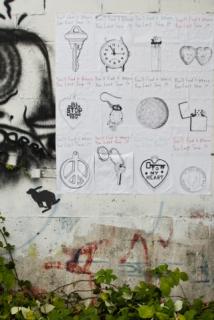
You’ll Find It Where You Last Saw It… artist unknown
Is a fictional character from my novel The Blue Light Projectcoming to life? A mystery is growing here.
I’ve just published a new novel about a street artist, the semi-fictional Rabbit. The book’s been getting amazing reviews. Banksy even tweeted about it recently. Not bad. In the book there are multiple photos of street art. Most of that work is by friends of mine, artists like JermIX, Cameraman, Rich S, A01 and legendary graffiti writer and train artist Take 5.
The piece pictured above, however, is by an unknown artist. It is based on a work described in the novel. Note the “Rabbit” tag on the piece at the bottom left corner. This is the subject of minor controversy in Vancouver as – since the book has come out – that tag has been appearing all over the place. Most often, it’s been going up near (or on) the work of Cameraman.
Like here, on one of Cameraman’s “Bring Back the Spring” posters.

Cameraman has grown kind of impatient about this. He’s teamed up with a documentary film crew who are running around interviewing everybody in the street art community in Vancouver.

And then this appeared in the alley behind the Monte Clark gallery:

That would be Cameraman. And yes, that would be a Rabbit trap. So things are apparently getting all serious. I just hope Rabbit – who is a character in a book, remember? – knows how to take care of himself in real life.
Please note that book is now available:
1) on AMAZON.ca
2) on AMAZON.com
3) or as an EBOOK right here
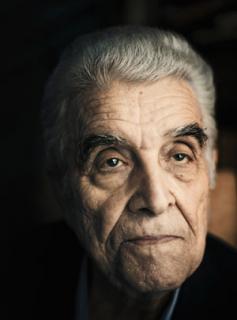
Rene Girard
I’m outed as an admirer of Girard by Humber College Professor of Political Philosophy Kent Enns. He’s writing about my new novel The Blue Light Project.
If you’re interested in Girard and the urgency of his ideas, you might enjoy the novel. About a three day hostage crisis at the studio of a controversial reality television show, the book takes on terror, celebrity, and their disturbing points of overlap.
Here is Professor Enns’ review of the book:
THE BLUE LIGHT PROJECT AND THE URGENCY OF THE NOW
Under the persistent sway of pecuniary-minded editorship, the mainstream of Canadian literature has for the past several decades massaged the novel-buying Canadian public with heartfelt, achingly personal “local fictions,” that are reassuring in their affirmations of love and domestic fortitude amidst Canada’s natural, rural and coastal glories. These fictions might be classified the way art historians refer to the mannered domestically-oriented still-lives and portraits of 16th Century Flemish painting: miniaturist. When this vein in Canadian literary fiction seemed all but overworked, our readership was regaled with the same domestic miniaturism but this time the ghosts of Canada’s history were set in motion along with the usual quotidian suspects. Of course, occasional exceptions peek above these re-iterations of the familiar (one thinks of Ondaatje, M. Richler, Atwood in her better books, and the crucial explorations of contemporary international experience, as Mistry has done). This now familiar miniaturism, it must be noted, has worked wonders for Canadian fiction on the international stage. Drawing on preconceptions of Canada as rural and morally righteous, our literary editorship has done much to bolster the Canada brand.
The way we live now, however, is deeply embedded in and expressed through the modalities of technology and globalized economics, politics and culture. And for those of us who turn to literature as an art form that takes up and explores central meanings and implacable contradictions in contemporary experience, those previously mentioned re-iterations of the familiar, however finely wrought, cannot but fail to be somewhat beside the point. In this contrast between the familiar Canadian miniaturist brand and the urgency of the globalized now, Timothy Taylor’s new novel, The Blue Light Project, takes its stand. As a writer who in his non-fiction has explored the vagaries of global fashions in travel, food, restaurant design, and popular culture, Taylor is an author with his finger on the pulse of contemporary taste and the pervasive economic and political forces that shape such sensibilities. Thus, subtly supporting this taut novel of confrontations between celebrity and politics, personal disgrace and the possibility of redemption, is an elaborate architecture of ideas.
One of the main clues to this structure is a relatively minor character named Girard. For those who keep up with debates in literary and anthropological theory, as well as in evolutionary psychology and the contemporary significance of religion, the name Rene Girard may ring a bell. (Perhaps the best introduction to his thought is the outstanding five-part CBC Ideas radio documentary, “The Scapegoat”.) Girard theorizes that archaic cultures have traditionally maintained their cohesiveness through sacrificial practices, where internal crises generate panic and contagious persecutorial fears and which find a release in the spontaneous killing of a scapegoat. Rituals and prohibitions found in every culture represent for Girard attempts to regulate crises and redeploy this beneficial outcome — hence the evidence of human and/or animal sacrifice in virtually every culture of which we have record, let alone the startling similarities in many foundational myths from different cultures in which an outsider figure is depicted as a pollution or threat and the community itself as innocent. Working against this tendency in the history of the West and now on an increasingly global scale are insights first expounded, according to Girard, in Biblical narratives (Joseph and Jesus are obvious examples) in which the collective is depicted as culpable and the intended sacrificial victim as innocent. Thus our modern concern with victims, with the oppressed and the downtrodden. This leaves us moderns in a precarious position– we crave, we may even need, the collective psychological satisfactions of sacrifice yet we also abhor and abjure the very production of victims that sacrifice (and perhaps even politics) requires.
And what has any of this to do with The Blue Light Project? In this finely executed novel, Timothy Taylor depicts the intersection of four lives, a burned out and disgraced journalist, a sporting celebrity, an unknown street artist, and a political terrorist whose motivations, in the end, expose themes central to this story. And undergirding a page-turner that will satisfy the most ardent of thrill seekers are two sacrificial structures that Taylor uncannily reveals to be at the core of contemporary experience: celebrity and Western expansionist politics. The hostage taking at the studios of a Canadian Idol-like program forces into our awareness the social usefulness and collective gratifications of a system that produces star after star and yet this same machinery repeatedly depicts the sacrificial downfall of our “polluted” idols — Charlie Sheen, anyone? Lindsay Lohan? Mel Gibson? We experience collective elations not only at their rise but their fall conduces to even greater satisfactions. Running parallel to this, in Taylor’s cultural-political economy, is a hidden system of sacrifice that bolsters modern expansionist democracies — the torture chambers, extra-ordinary renditions and extraditions, and the quasi-legal gulag of off-shore detention facilities that covertly enforce Western ideals and protect our culture from further exposures of its core contradictions.
By placing his novel at the centre not only of contemporary life but also in the flux of beliefs and morally contradictory practices that sustain globalized living in the West, Taylor relentlessly insists that the vocation of Canadian fiction is in the now, it is in the Twitter feeds and popular media, the international trends and the political machinations that churn endlessly at our lives. Taylor’s response to the staid “local fictions” of much Canadian literature is to give us an unnamed city that is as “linked in” and connected as any on the planet. The Blue Light Project has a lot of balls in the air — fame and celebrity, street art, politics and the secret service, Girard and sacrifice — and Timothy Taylor masterfully balances these things. And many others. Miniaturist it is not. It is a genuinely moving novel, building to a great climax and with a denouement that provokes the kind of reflection on what has happened, on how it has been depicted, that only the best fiction can do.
Kent Enns is Professor of Political Philosophy at Humber College in a city named Toronto.
Read more about The Blue Light Project, or even obtain a copy, at AMAZON.ca orAMAZON.com. It can also be downloaded as an EBOOK here.
]]>
Nine O’Clock Alarm Clock: Cameraman and Emma
I’ve just published a new novel about a street artist, the semi-fictional Rabbit. The book’s been getting amazing reviews.
Then the other day Banksy tweeted about it. Nice!
But this series of posts isn’t about the book. It’s about the artists in my part of the world who inspired Rabbit and make him “semi-fictional”. Artists whose work ended up in the book as photographs: JermIX, Cameraman, Rich S, A01 and legendary graffiti writer and train artist Take 5.
(There were others who didn’t want to be named.)
Please note that book is now available:
1) on AMAZON.ca
2) on AMAZON.com
3) or as an EBOOK right here
This first photo I’ll highlight is a piece by Cameraman and Emma, Vancouver artists who work with photography and sound respectively. They collaborated to make this alarm clock. It lit up bright orange and started ringing at 9:00 PM one winter’s night in the Strathcona neighborhood in Vancouver.
The sound came from dozens of dollar-store alarm clocks hidden in the weeds nearby. It sounded like a million crickets singing at once.
Wish you could have been there. People were running out of their houses and studios to stand in the street and watch.
People were talking to strangers.
People were smiling.
Unfortunately, since those little dollar-store alarm clocks aren’t very smart, the clock rang again at 9:00 AM the next morning. Someone wasn’t very happy about that and took a baseball bat to all those poor little clocks.
Still, it was a glorious thing while it lasted. It was one of the first pieces of street art I witnessed go up and “go off”. It marked the beginning of something for me. An obsession.
Also, a novel, which I’d be honored if you checked out.
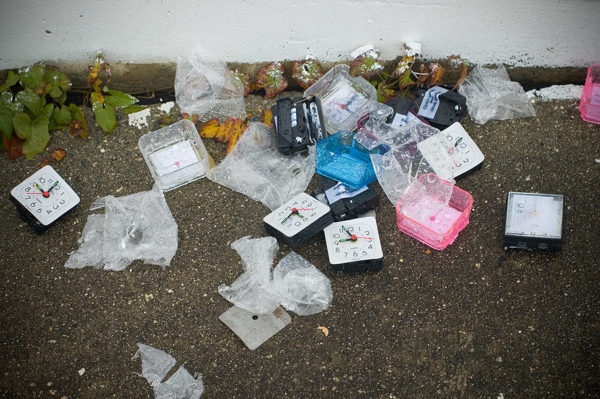
The Blue Light Project is available:
1) on AMAZON.ca
2) on AMAZON.com
3) or as an EBOOK right here
Check in for Part II of this series. I’ll be looking at a piece by the mysterious, elusive Rabbit.
]]>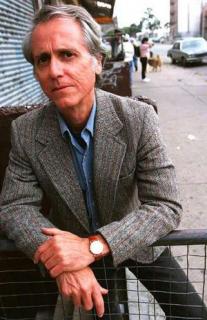 I’m hugely flattered by some recent and heavy praise for The Blue Light Project, a “thriller that makes you think” about a hostage crisis in a television studio.
I’m hugely flattered by some recent and heavy praise for The Blue Light Project, a “thriller that makes you think” about a hostage crisis in a television studio.
In each of these reviews, I’ve been compared to Don Delillo, who is a serious hero of mine. That comparison leaves me speechless (almost) but grateful.
The book is now available. Please have a look:
1) on AMAZON.ca
2) on AMAZON.com
3) or as an EBOOK right here
Here are the amazing review quotes:
Best of all – and here is where the writer he most recalls is Don DeLillo – Taylor finds surprising angles into his material. A man holding lives in his hands, in a position to demand almost anything, wants only to talk to a small-time journalist. Why? The answer would be unfair to reveal in a review, but it can be said that when it is revealed, what’s offered is not a neat resolution but a whole new set of questions, their implications spreading in all directions. Ian McGillis, MONTREAL GAZETTE Read the full review
The best thing Timothy Taylor has written yet. He has DeLillo-like moments here, if DeLillo were to climb out of the limousineand hang out in the back alleys for a while. Taylor has DeLillo’s knack for seeing the ¬connections between seemingly unconnected things and assembling them into a portrait of our time. Call him a street artist of the page. Peter Darbyshire VANCOUVER PROVINCE Read the full review.
Timothy Taylor is Canada’s DeLillo. The Blue Light Project really brings it into focus. Art, reality TV, celebrity – it’s all here. The last 20 or so pages are unimaginably great, some of the best writing you will read. It’s paced like a thriller, a taut thriller and in its own way, it’s that as well. But it’s also an extremely profound – and at time hilarious – meditation on our celebrity obsessed culture and our need for “reality” in entertainment. Highly recommended. Arjun Basu, Content Director, Spafax
The Blue Light Project is available now:
1) on AMAZON.ca
2) on AMAZON.com
3) and as an EBOOK
]]>